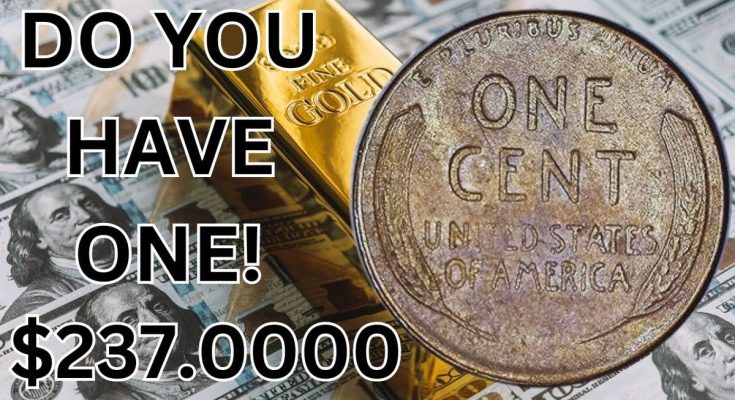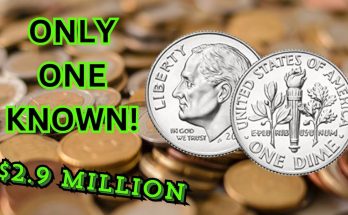Description:
Have you ever dreamed of finding a hidden treasure right in your pocket change? Believe it or not, some of the most valuable coins in the world are ordinary-looking pennies that millions of people have handled without realizing their worth. The photo above shows the famous Lincoln Wheat Cent, one of the most iconic coins in U.S. history. At first glance, it might look like just a regular “One Cent” coin, but certain rare versions of this penny have made collectors and lucky finders incredibly rich — in some cases worth hundreds of thousands or even millions of dollars!
The image captures a classic Lincoln Wheat Penny, easily identified by the “ONE CENT” inscription surrounded by two wheat ears on the reverse side. This design was minted between 1909 and 1958, replacing the Indian Head cent and marking the beginning of the Abraham Lincoln penny era. Lincoln’s portrait on the front was a tribute to the 100th anniversary of his birth, and it became the first U.S. coin to feature a real historical figure.
But why would such a small copper coin be worth so much? The answer lies in minting errors, rare dates, and historical significance. Some pennies were struck using the wrong metal, others have unusual markings or small differences that make them extremely scarce. For example, the 1943 Copper Wheat Penny is one of the most famous and valuable coins ever made in the United States. During World War II, the U.S. Mint switched from copper to zinc-coated steel to conserve copper for war supplies. However, a few copper planchets (coin blanks) accidentally remained in the presses and were struck with the 1943 date. These rare copper pennies are now worth hundreds of thousands of dollars, and in pristine condition, can exceed $1 million at auction!
Other highly sought-after Lincoln pennies include:
-
1909-S VDB Lincoln Cent: The first year of issue, with designer Victor David Brenner’s initials (VDB) on the reverse. Only 484,000 were minted in San Francisco, making it one of the most desirable coins in U.S. history. Value can reach over $2,000 to $50,000 depending on condition.
-
1955 Double Die Obverse: A true collector’s gem, this penny features a clear doubling of the date and lettering (“LIBERTY” and “IN GOD WE TRUST”). Well-preserved examples sell for $1,000 to $20,000 or more.
-
1944 Steel Penny: Another minting mistake from the World War II era. A few leftover steel planchets from 1943 were accidentally struck with the 1944 date. These coins are among the rarest Lincoln cents, worth $75,000 to $200,000+.
-
1969-S Double Die Obverse: Recognized by strong doubling on the front details, these are highly collectible and can sell for tens of thousands of dollars.
-
1972 Double Die, 1992 Close AM, and 1999 Wide AM pennies — all have small design variations that make them valuable to experts and collectors alike.
The background of the image, showing stacks of gold bars and U.S. hundred-dollar bills, symbolizes the incredible value these tiny coins can hold. The large text — “DO YOU HAVE ONE! $237,000.00” — captures the excitement many feel when learning that a simple penny could be a life-changing discovery. Finding one of these rare varieties could genuinely allow someone to retire early, especially if the coin is in uncirculated or mint condition.
Many people unknowingly have old Wheat pennies stored away in jars, drawers, or inherited coin collections. It’s worth checking each coin carefully — especially the date and mint mark (small letters like “D” for Denver, “S” for San Francisco, or no mark for Philadelphia). Using a magnifying glass or coin app can help identify small details that separate an ordinary penny from a priceless one.
Collectors and investors around the world actively buy and sell these coins through online auctions, coin shows, and certified grading services like PCGS (Professional Coin Grading Service) and NGC (Numismatic Guaranty Company). Proper grading is crucial because the condition (ranging from “Good” to “Mint State”) greatly influences the final price. A common coin in poor condition might be worth only a few cents, while the same coin in pristine condition can fetch thousands.
The fascination with the Lincoln cent also stems from its deep connection to American history. Introduced during the presidency of Theodore Roosevelt, the coin was part of a broader artistic movement to beautify U.S. currency. It has remained in continuous circulation for more than a century, making it one of the most enduring and beloved coins ever struck.
So, if you ever come across a Wheat Penny, don’t dismiss it as just another old coin. Flip it over, check the year, and examine it carefully. You could be holding a piece of history worth far more than one cent. With rare examples selling for anywhere from $10,000 to over $2 million, even the most modest coin jar could hide a fortune waiting to be discovered.
The message of the photo is clear and exciting: “DO YOU HAVE ONE?” Because if you do, it could be your ticket to financial freedom. From the 1909-S VDB to the legendary 1943 copper penny, these coins prove that sometimes, small things truly hold great value. Check your change, dig through your old collections, and keep your eyes open — your next penny might just make you a millionaire.



